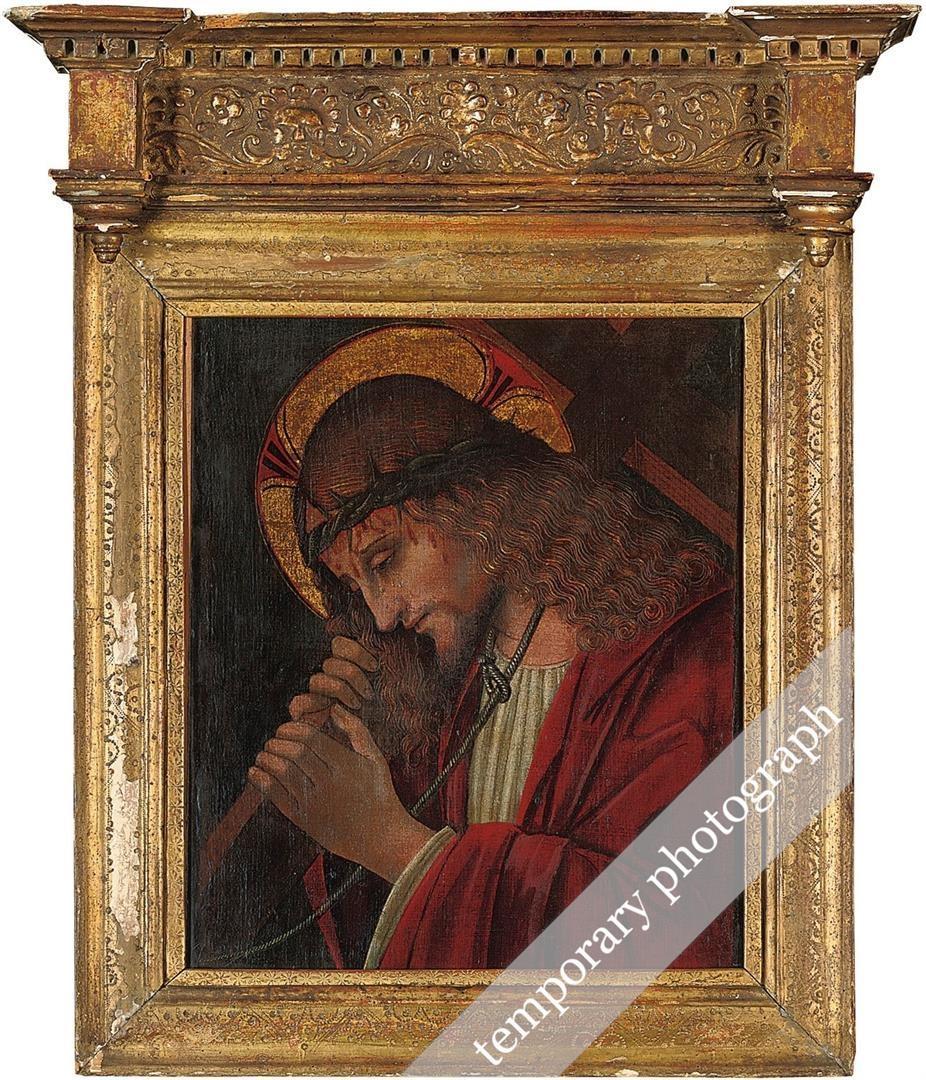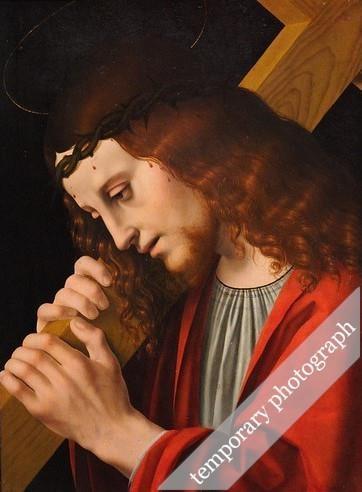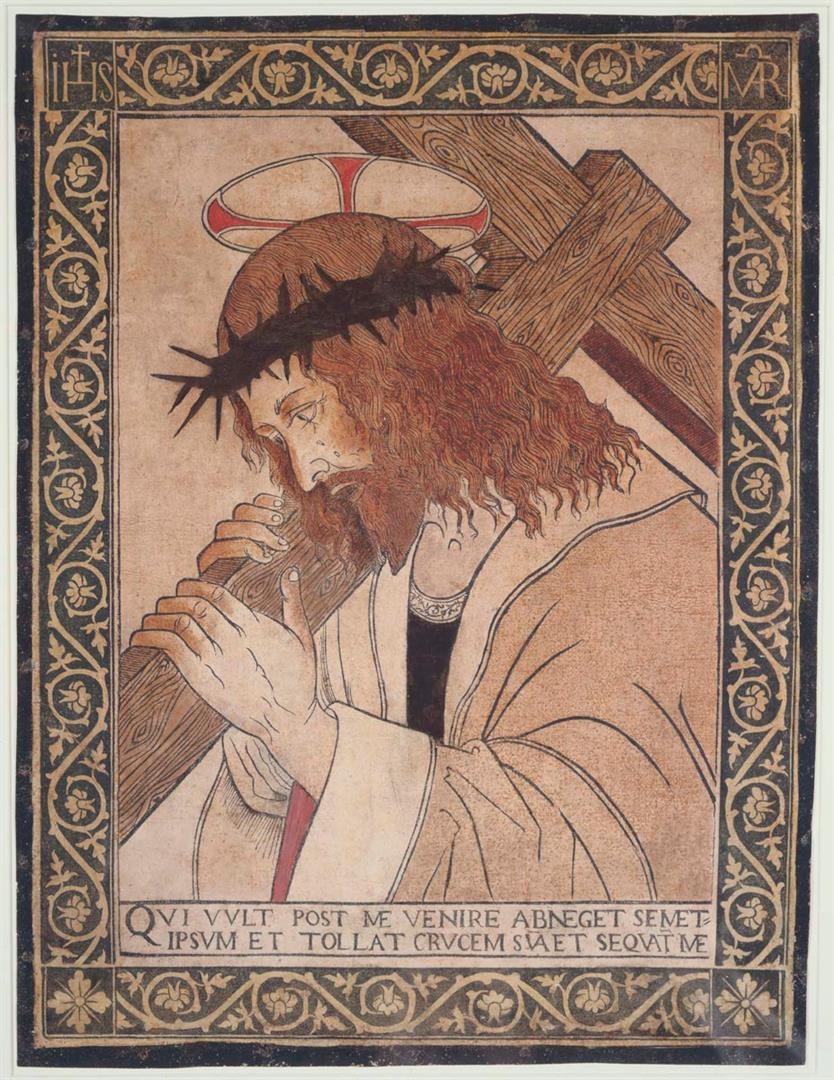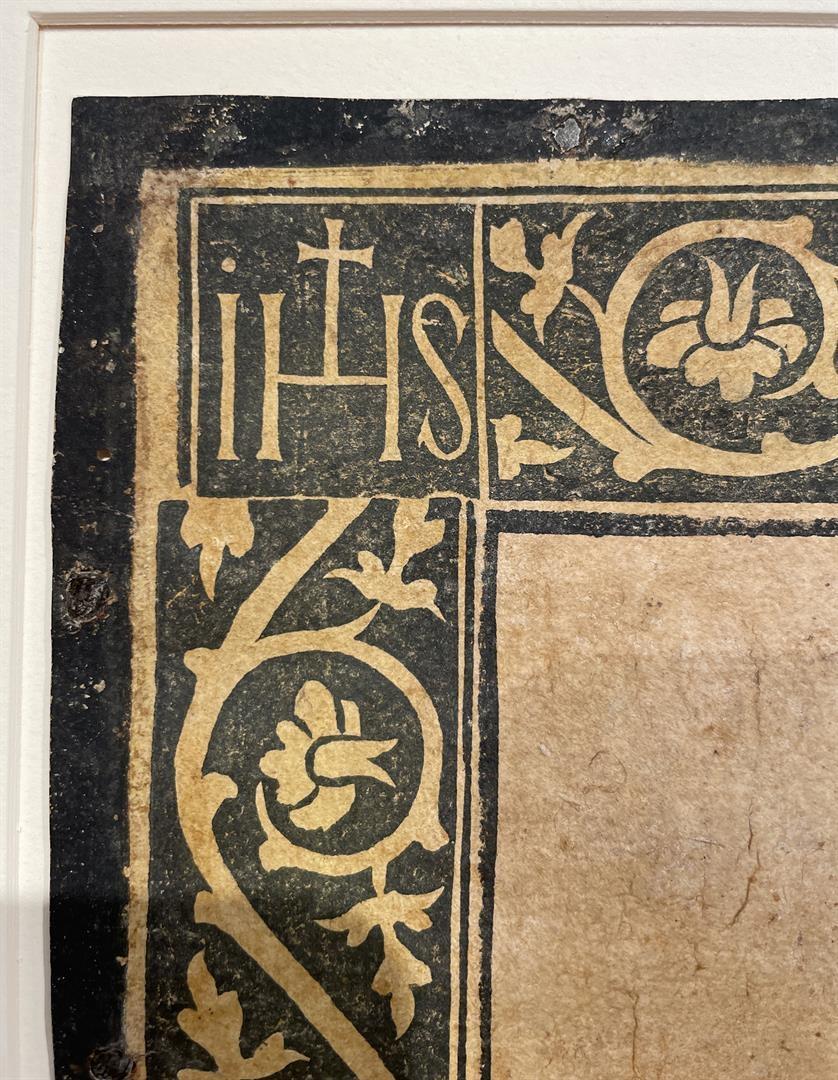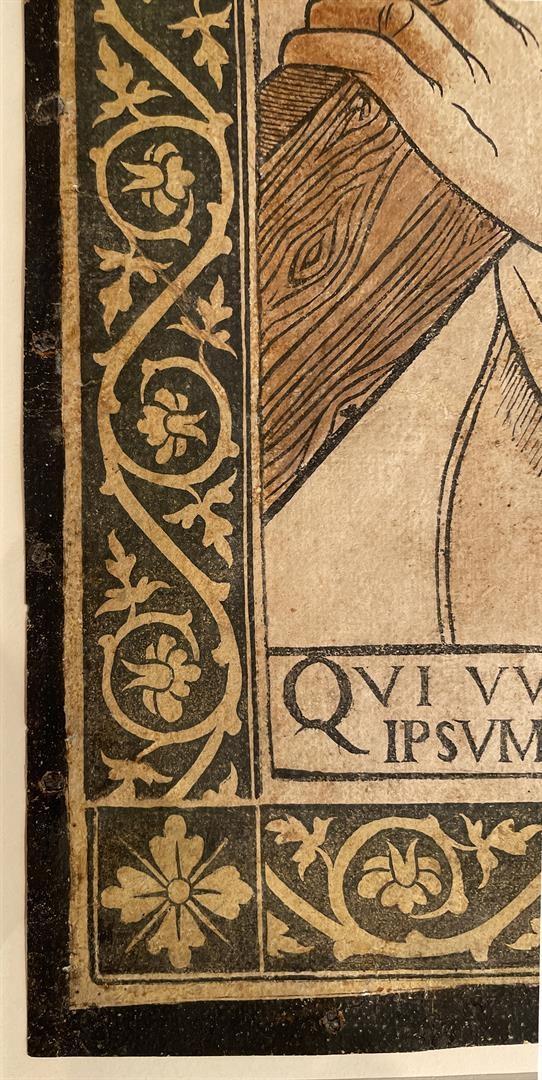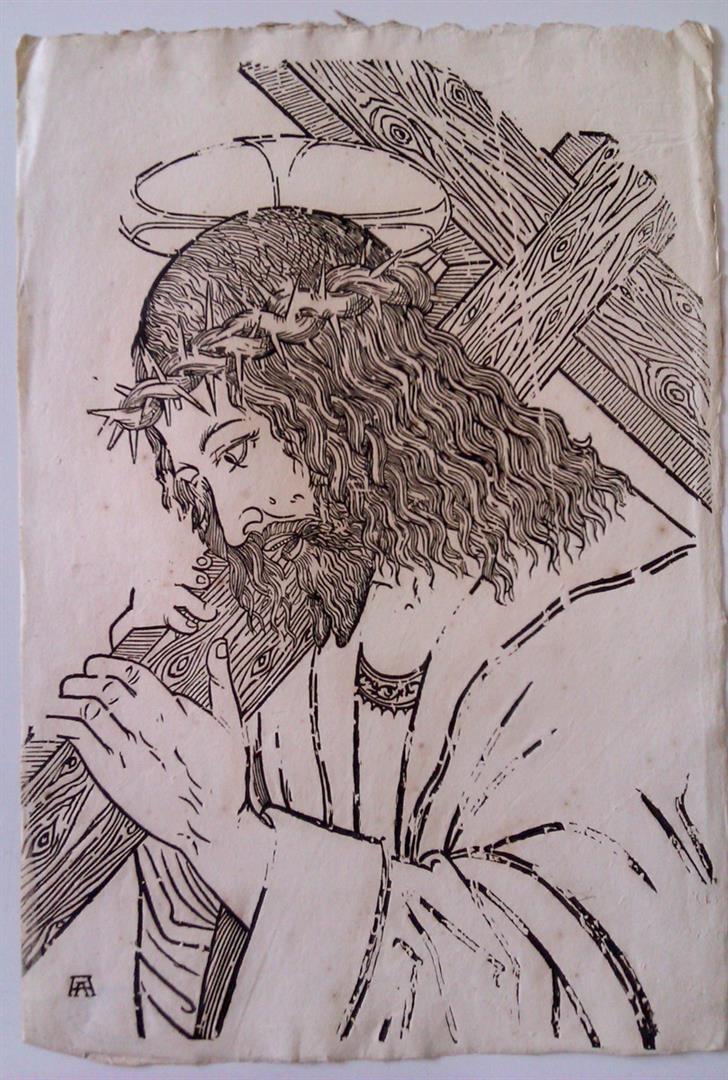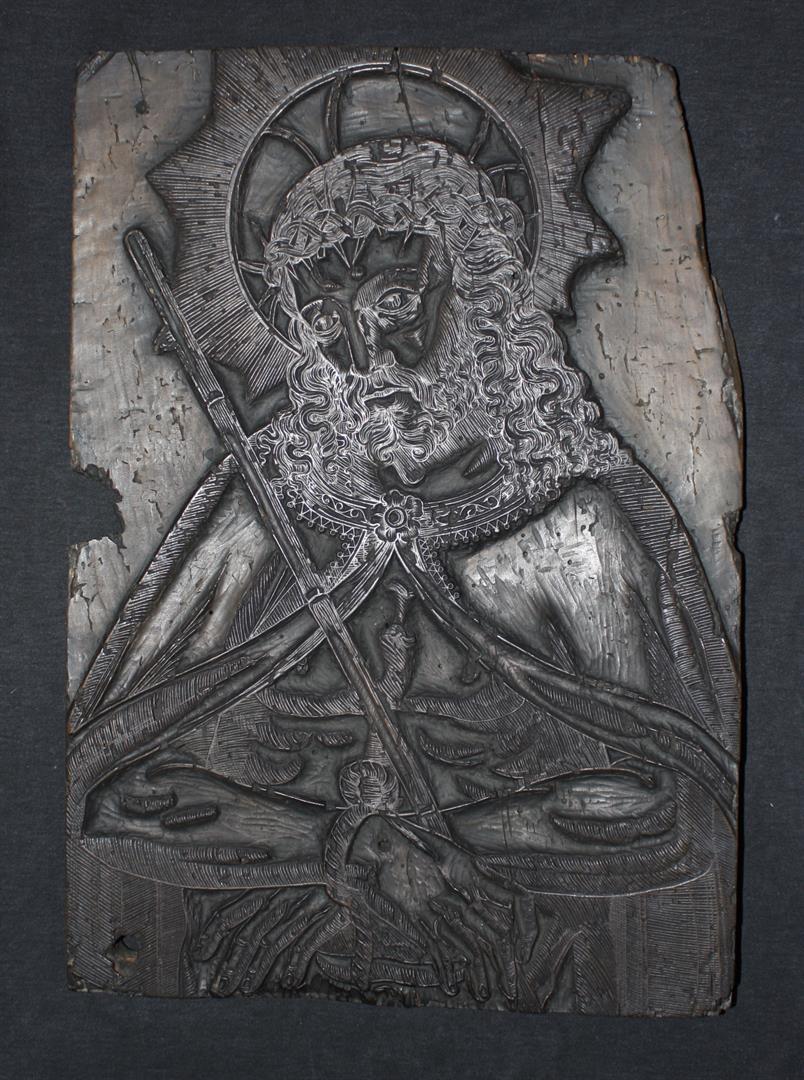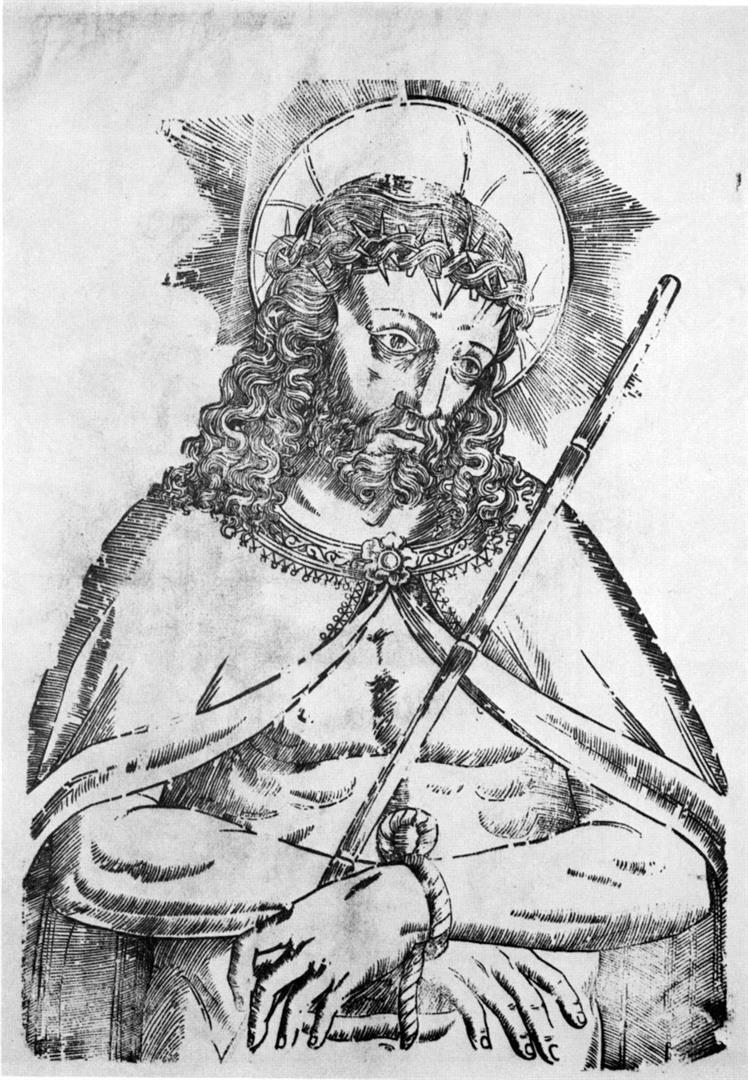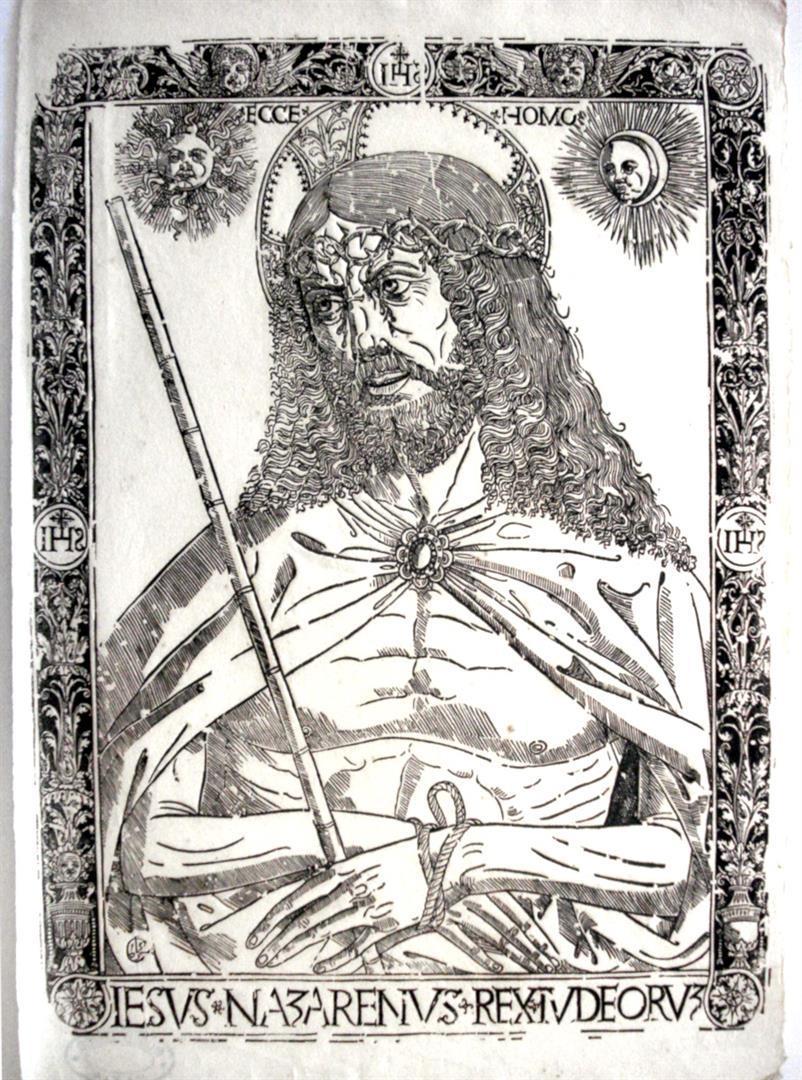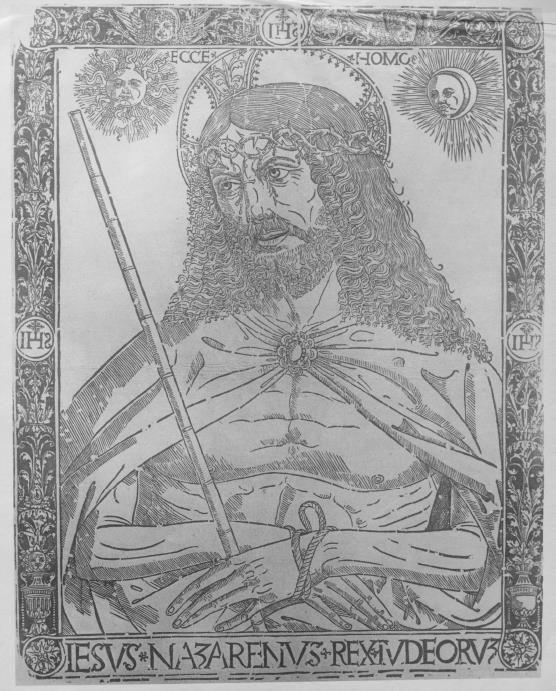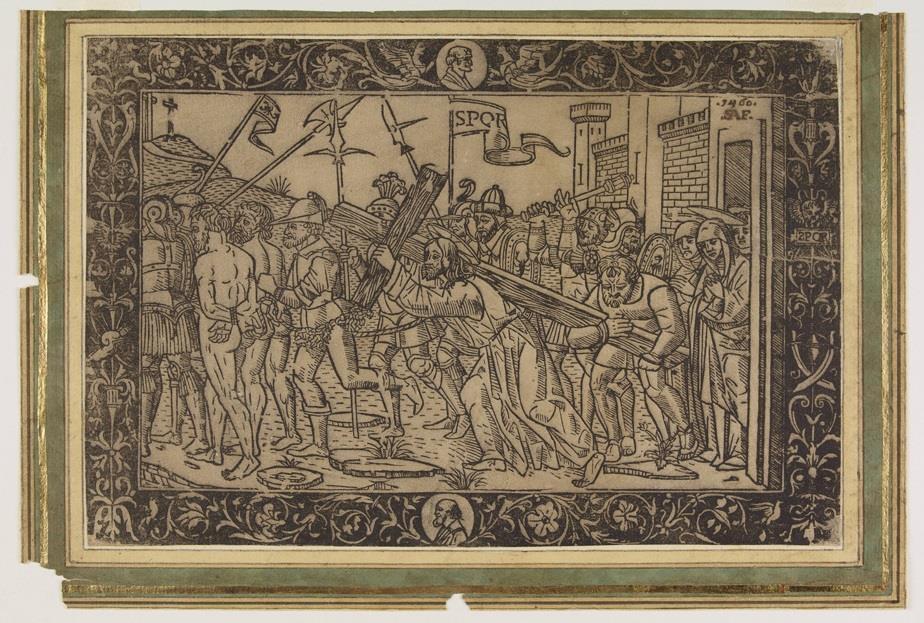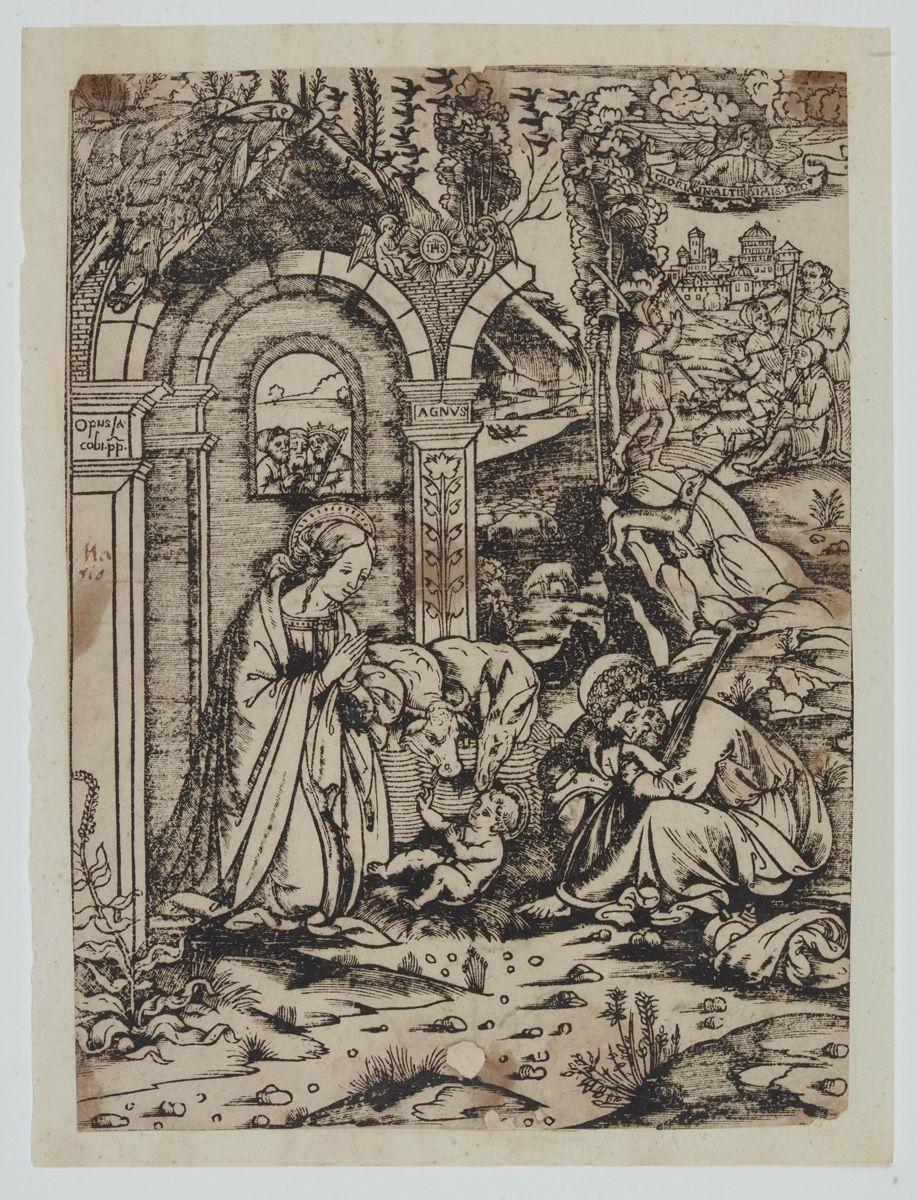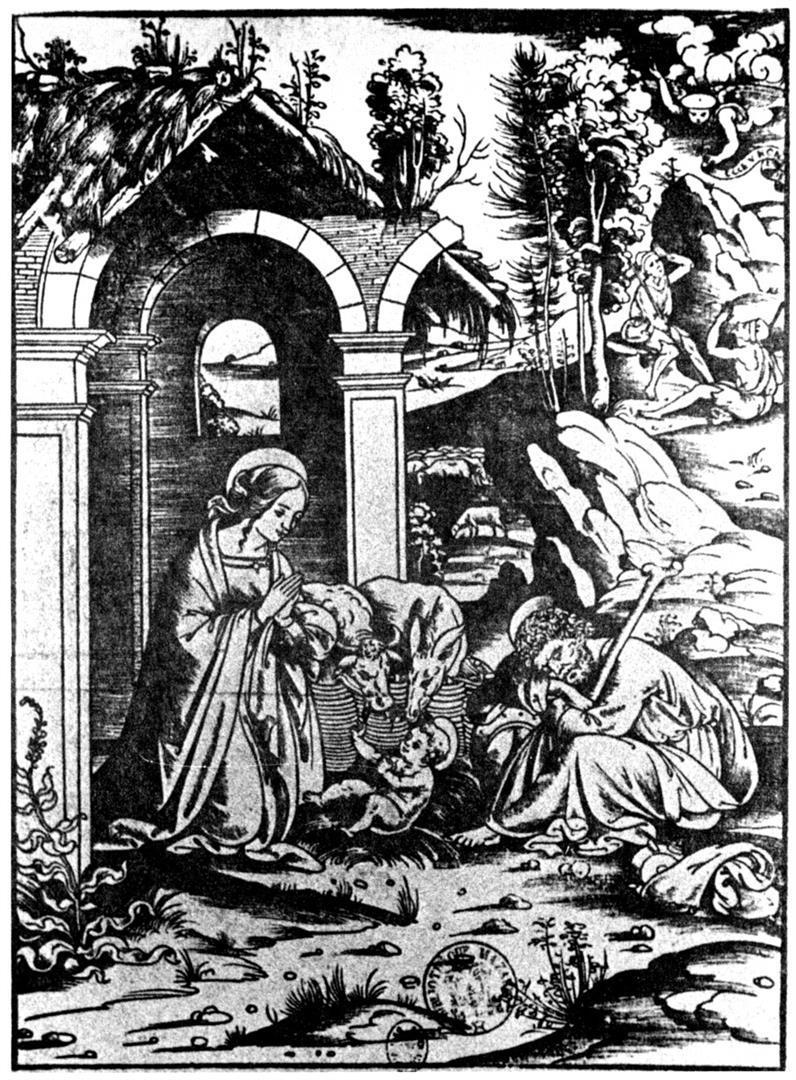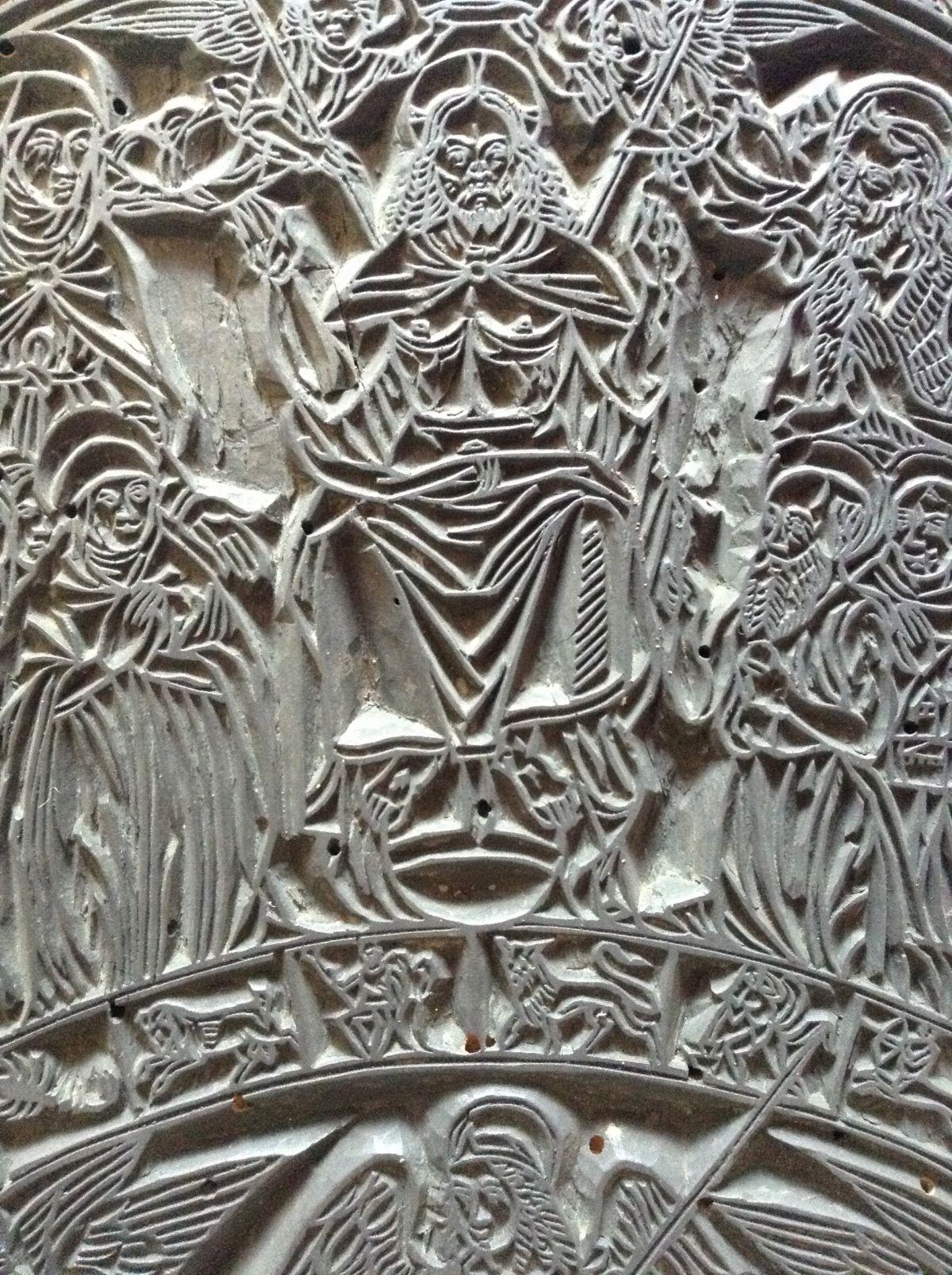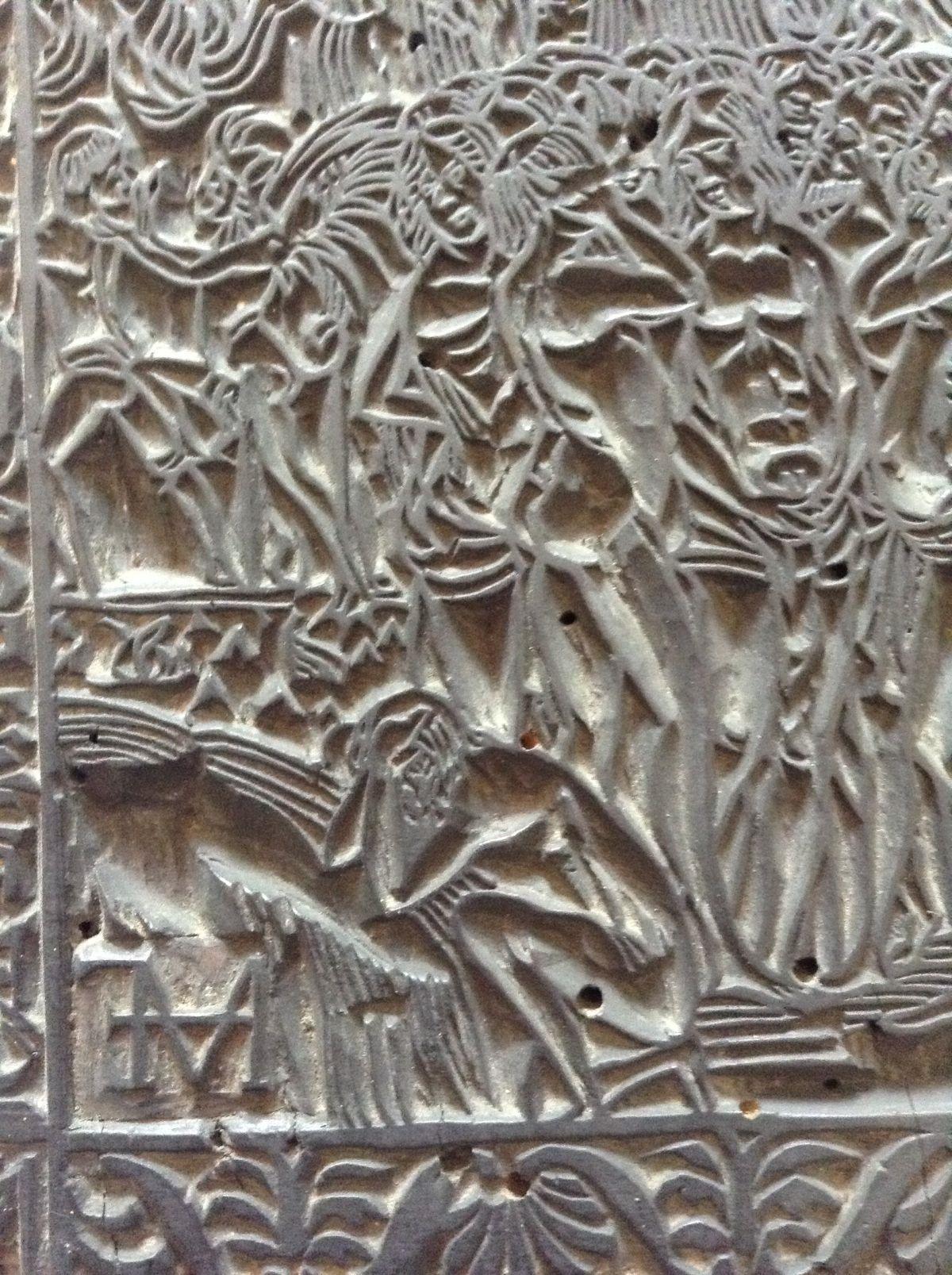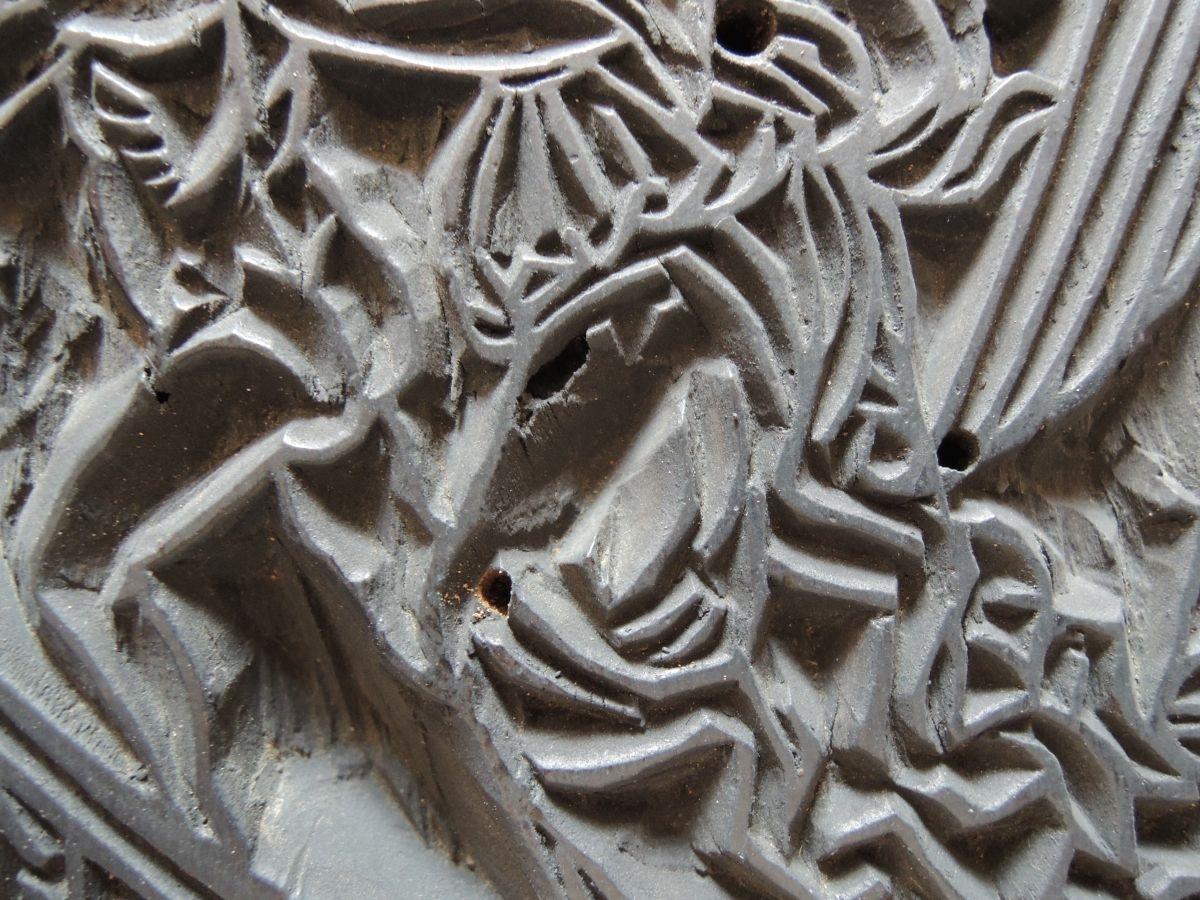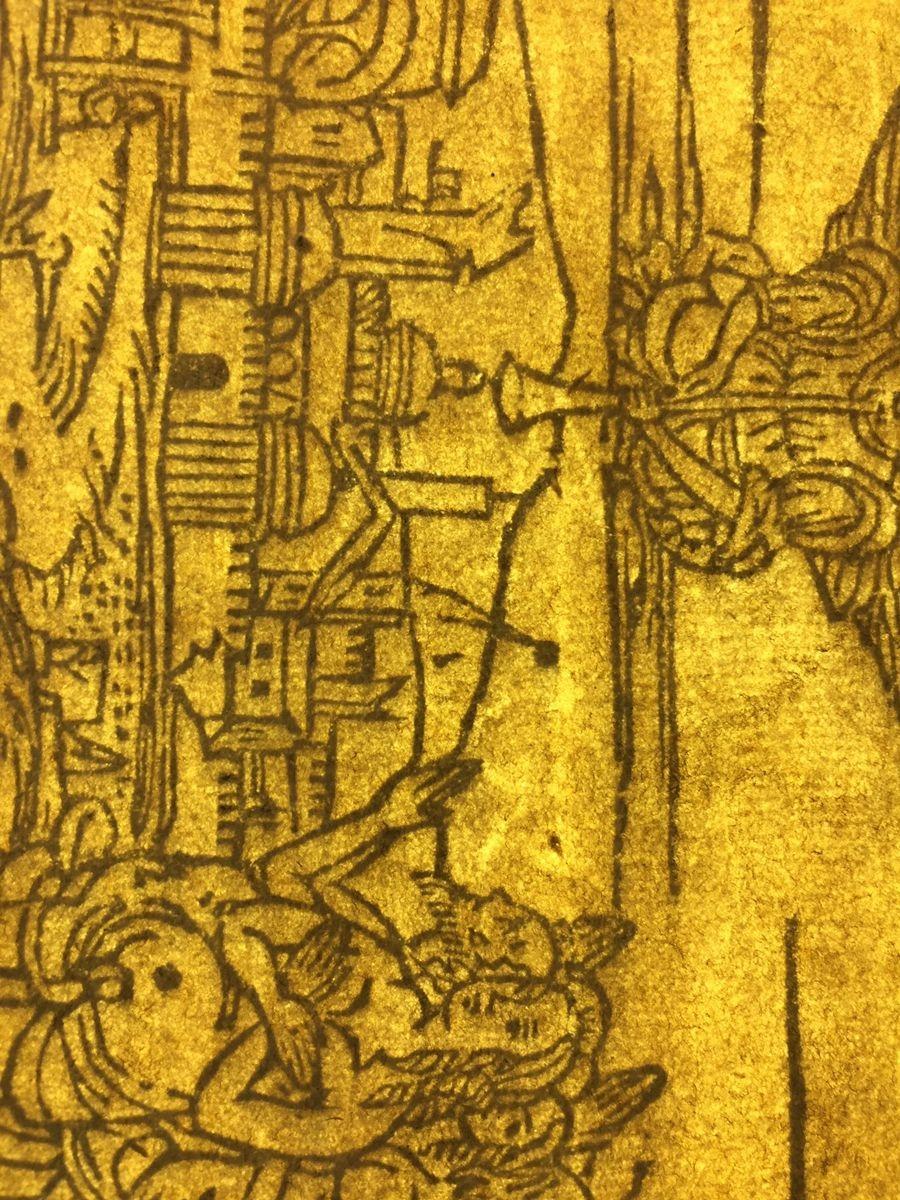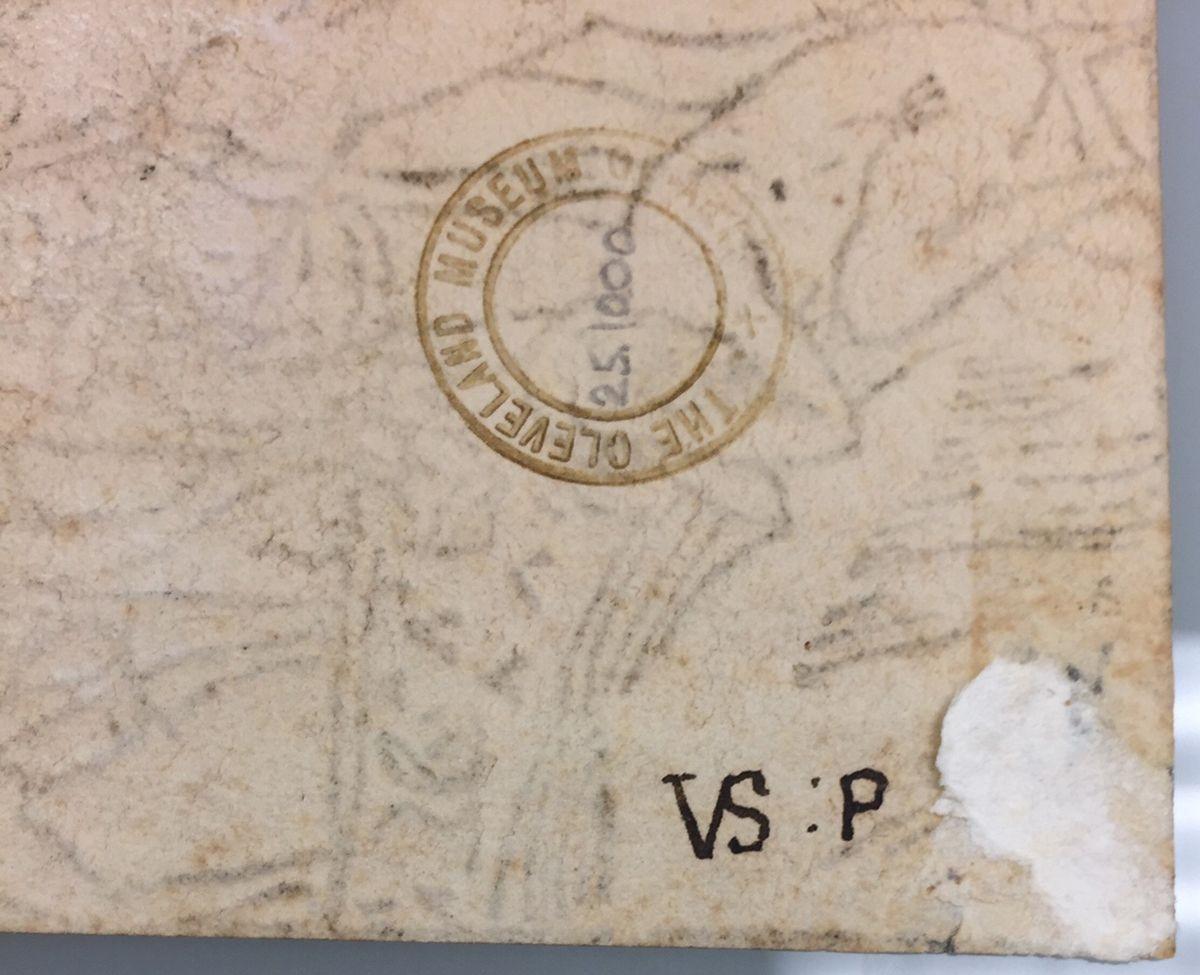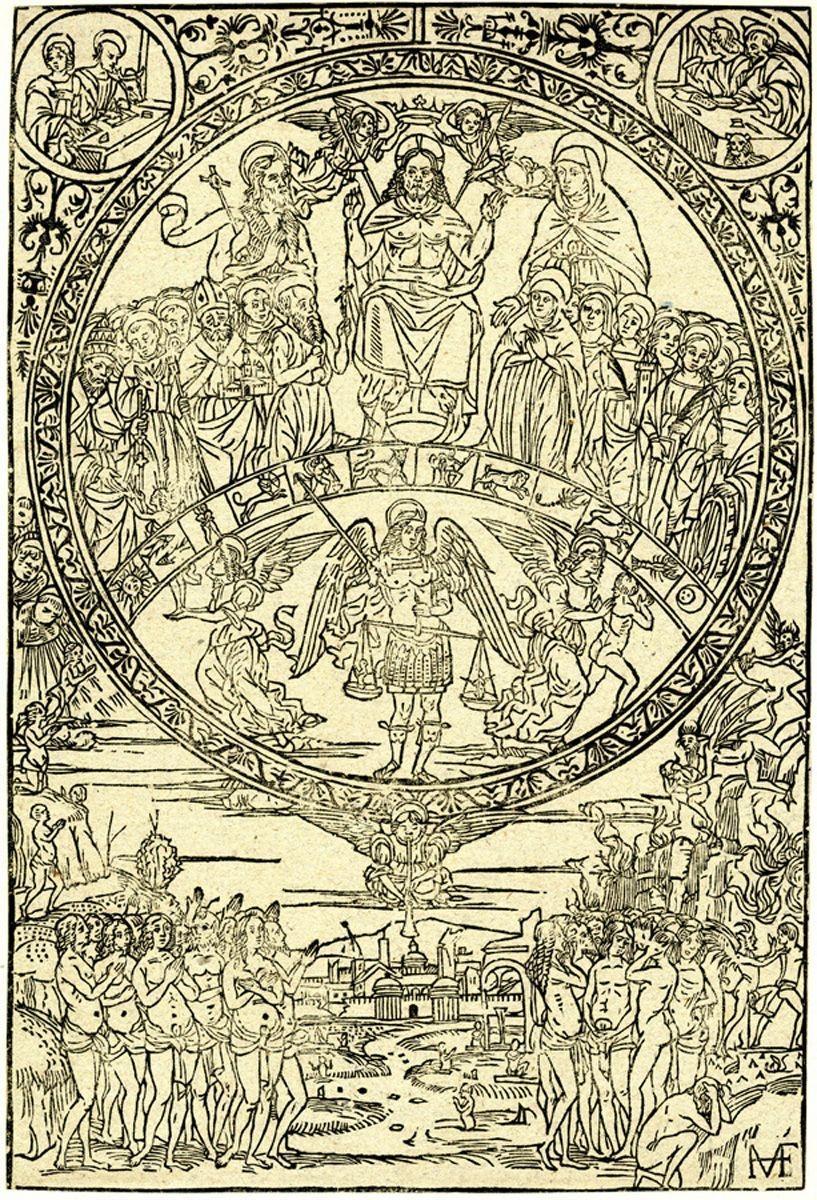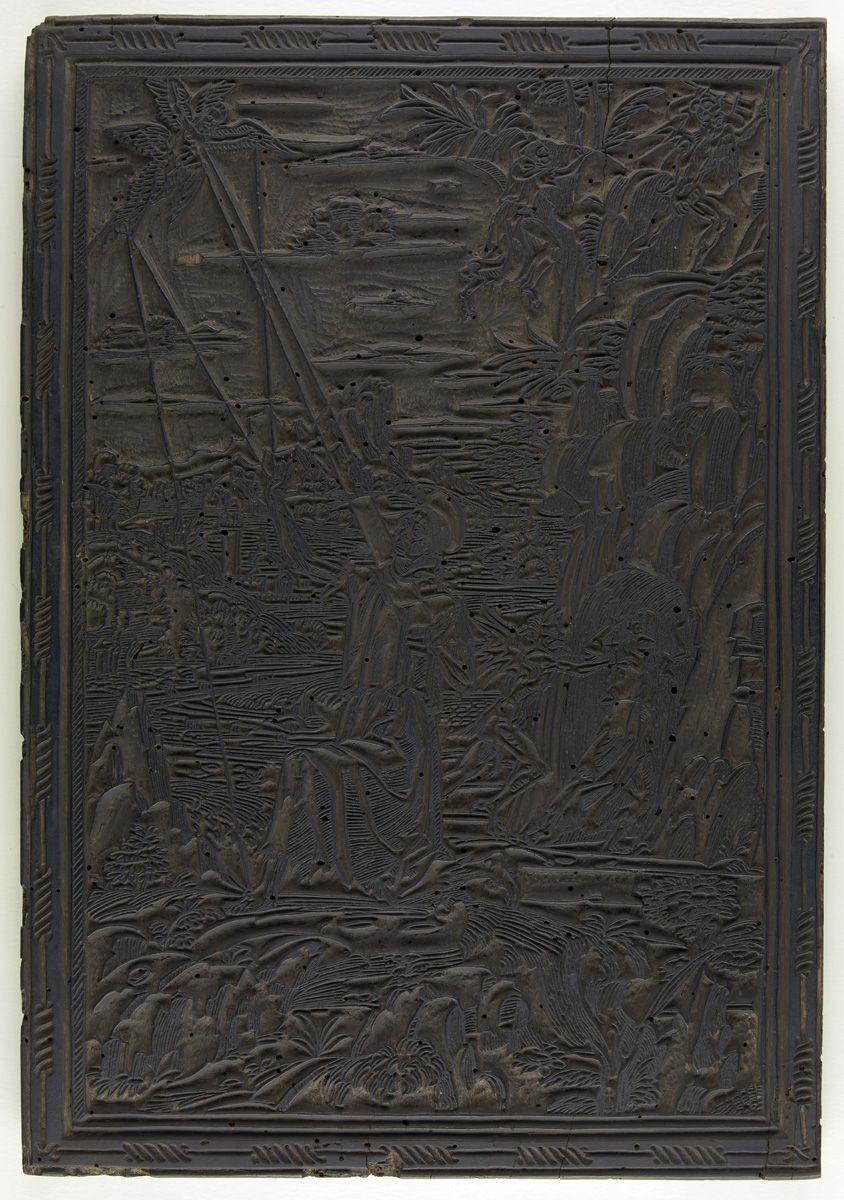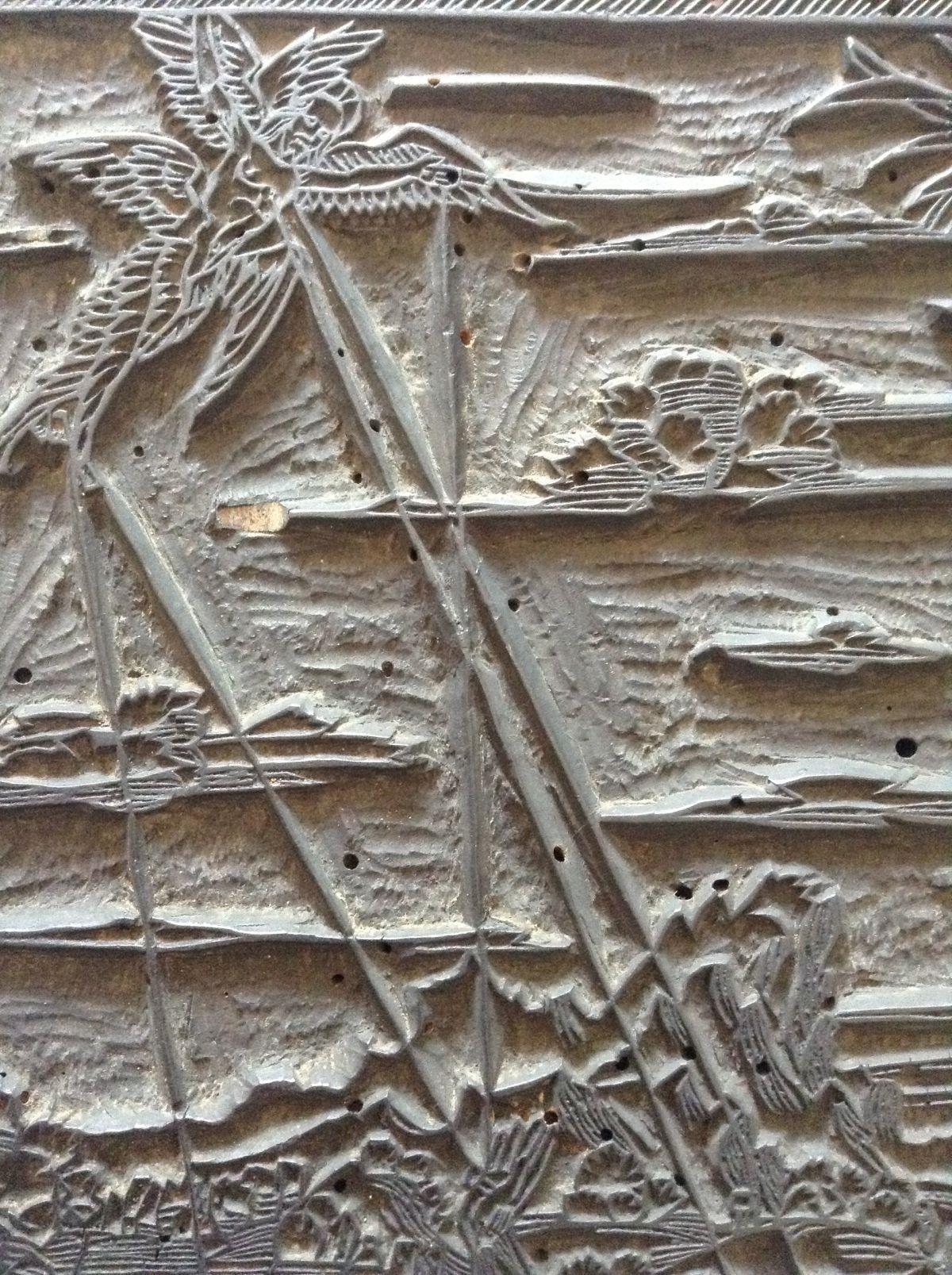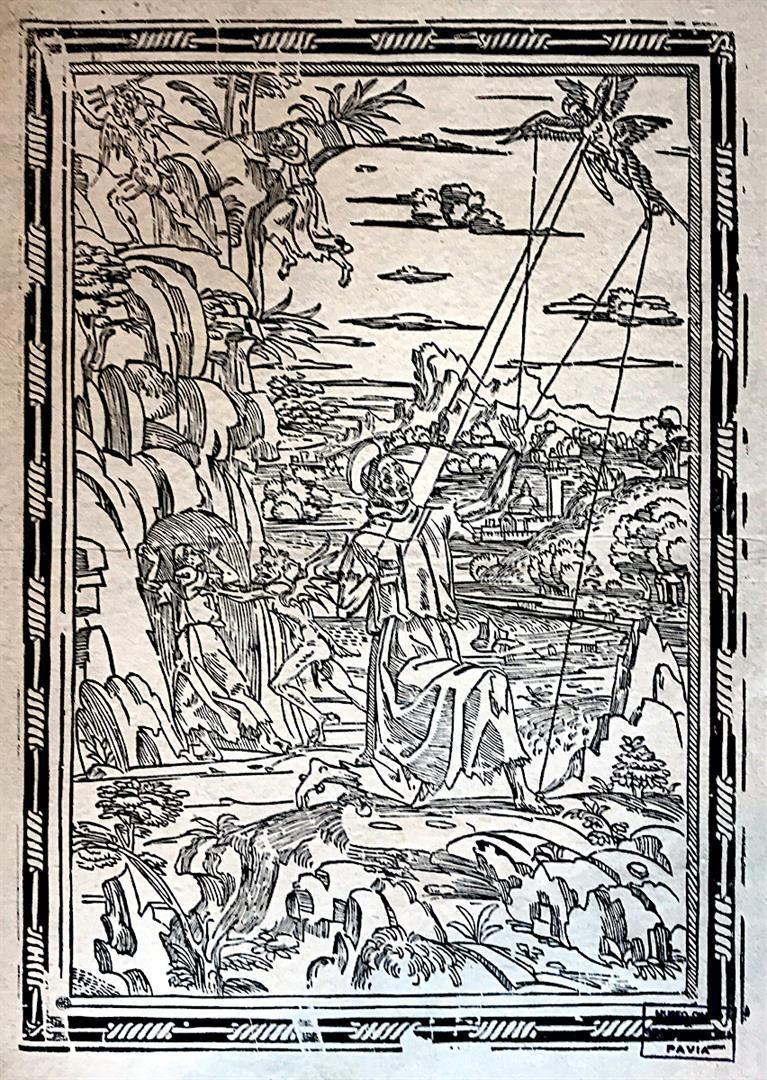Census of Italian Renaissance Woodcuts
L'Atlante delle xilografie italiane del Rinascimento (The Census of Italian Renaissance Woodcuts) is the result of a research project designed to study and catalogue woodcut graphic material and wood blocks made in Italy from the time of the first known examples up to about 1550.
This involved examining singe-sheet prints and wood blocks preserved in public and private collections or still in their places of origin, such as churches and convents.
The digital archive can be consulted using various search keys. It has constantly updated images and files and is linked to the major international databases in the sector.
The aim of the project and of the Digital Archive is also to be a reference point for the study of Italian woodcuts by creating an active and updated network involving art historians, woodcut experts and the institutions that hold the materials surveyed.
We invite you to contact us at italianwoodcuts.census@cini.it to inform us about new items to be catalogued, to supplement and correct the information provided in the entries, to explore topics together and to let us know about any new publications.
In 2021, the project benefited from a prestigious grant from the Getty Foundation of Los Angeles as part of The Paper Project: Prints and Drawings Curatorship in the 21st Century, which finance training, curating, cataloging of graphic materials. In 2022, the Census of Italian Renaissance Woodcuts also received funding from the International Fine Prints Dealers Association (IFPDA) to support research and cataloging.
Materials in the catalogue entries
Woodcuts on single sheets and in books are the Cinderella of engraving studies, a discipline that has seen some major but discontinuous research in Italy. The first and most obvious result of the Digital Archive has been the salvaging of previously unknown or little-known works of art, scattered in the most disparate places. The rarity and fragility of the materials makes their recovery desirable also for the purpose of safeguarding them.
These hitherto "invisible" (several were even unknown in the literature) contain precious information that enhances our knowledge of Renaissance art. Firstly, from the point of view of the history and evolution of style for which we know that during the early Renaissance the principle of the unity of the arts reigned in artists' workshops and the great masters resorted simultaneously to various artistic practices, also providing designs for the new art of engraving in all its forms. Moreover, an atlas of images that can be compared enables us to suggest areas of figurative production and groups of stylistic families, creating new artistic identities or enriching the catalogue of masters and known monogrammists.
The rediscovery and study of these woodcuts also contributes to knowledge of religious and secular customs and, more generally, to the history of Renaissance culture by shedding light on the interweaving of learned and popular culture, the frequent presence of texts, and the variety and originality of the subjects of the sheets (official and apocryphal Gospels, lives of saints, historical events, medicine, magic, games, satire, geography and portraiture).
Instructions for consultation
Each woodcut is assigned a code, i.e. the identification number of the census preceded by the prefix 'ALU.' (acronym of Aldovini-Landau-Urbini): for example, ALU.0700. In the case of wood blocks, the number is followed by '-M': for example, ALU.0290-M. In the case of several copies of the same print, the number is followed by '.1, .2, .3
': for example, ALU.0290.1, ALU.0290.2.
The order for the bibliographic citation of an entry is:
Name of the author of the entry, Atlante delle xilografie italiane del Rinascimento, acronym ALU followed by the relevant number, permalink
For example: L. Aldovini, Atlante delle xilografie italiane del Rinascimento, ALU.0001.1, permalink, ISBN 978-88-96445-24-2.
italianrenaissancewoodcuts.com
filters
- physical location
- Londra, British Museum239
- Berlino, Staatliche Museen116
- Modena, Gallerie Estensi112
- Milano, Civica Raccolta delle Stampe Achille Bertarelli67
- Vienna, Albertina59
- show full list
- Parigi, Bibliothèque nationale de France50
- Brema, Kunsthalle44
- Ravenna, Istituzione Biblioteca Classense43
- New York, Metropolitan Museum of Art42
- Budapest, Museum of Fine Arts - Szépmüvészeti Múzeum41
- Ubicazione sconosciuta37
- Parigi, Musée du Petit Palais35
- Pavia, Musei Civici35
- Washington D.C., National Gallery of Art32
- Rouen, Bibliothèques municipales31
- Bassano del Grappa, Museo Civico30
- Boston, Museum of Fine Arts30
- Copenhagen, Statens Museum for Kunst28
- Norimberga, Germanisches Nationalmuseum25
- Città del Vaticano, Biblioteca Apostolica Vaticana20
- Dresda, Staatliche Kunstsammlungen20
- Roma, Istituto Centrale per la Demoetnoantropologia20
- Amsterdam, Rijksmuseum16
- Parigi, Musée du Louvre16
- Assisi, Chiesa di San Damiano15
- Ghent, Ghent University Library14
- Washington D.C., Library of Congress14
- Venezia, Museo Correr12
- Amburgo, Kunsthalle10
- New York, The Morgan Library10
- Parma, Biblioteca Palatina10
- Firenze, Gallerie degli Uffizi9
- Londra, British Library9
- Collezione privata8
- Venezia, Archivio di Stato di Venezia8
- Francoforte, Staedel Museum7
- Milano, Biblioteca Ambrosiana7
- Brescia, Pinacoteca Tosio Martinengo6
- Cambridge (MA), Harvard University Library6
- Monaco di Baviera, Staatliche Graphische Sammlung München6
- Roma, Istituto Centrale per la Grafica6
- Venezia, Fondazione Giorgio Cini6
- Innsbruck, Tiroler Landesmuseen5
- Los Angeles, Los Angeles County Museum of Art5
- Milano, Raccolte Artistiche del Castello Sforzesco5
- New York, New York Public Library5
- Vienna, Österreichische Nationalbibliothek5
- Windsor, Royal Collection Trust5
- Braunschweig, Herzog Anton Ulrich-Museum4
- Cambridge (MA), Harvard Art Museums4
- Firenze, Biblioteca Nazionale Centrale di Firenze4
- Londra, Victoria and Albert Museum4
- Oxford, Bodleian Library4
- Varese, Monastero di Santa Maria del Monte sopra Varese4
- Venezia, Biblioteca Nazionale Marciana4
- Venezia, Fondazione Musei Civici di Venezia4
- Chicago, Newberry Library3
- Leida, Leiden University Library3
- Milano, Museo Bagatti Valsecchi3
- Milano, Palazzo del Monte di Pietà3
- New Haven, Yale University Art Gallery3
- Oxford, Ashmolean Museum3
- Parigi, Bibliothèque Sorbonne3
- Philadelphia, Philadelphia Museum of Art3
- Praga, Czech National Library3
- Torino, Palazzo Madama3
- Wolfenbüttel, Herzog August Bibliothek3
- Bakewell, Chatsworth House2
- Basilea, Historisches Museum2
- Basilea, Kunstmuseum Basel2
- Basilea, Universitats-Bibliothek2
- Bergamo, Biblioteca Civica Angelo Mai2
- Bologna, Biblioteca Comunale dell'Archiginnasio2
- Cleveland, The Cleveland Museum of Art2
- Helsinki, University of Helsinki2
- Modena, Biblioteca Estense Universitaria2
- New Haven, Yale University Beinecke Library2
- New York, Collezione privata2
- New York, Collezione privata Theodore B. Donson2
- Parigi, École nationale supérieure des Beaux-Arts2
- Pesaro, Biblioteca Oliveriana2
- Reggio Emilia, Biblioteca Panizzi2
- Roma, Biblioteca Angelica2
- Roma, Biblioteca Nazionale Centrale di Roma2
- San Francisco, Fine Arts Museum2
- San Pietroburgo, Hermitage Museum2
- Zurigo, Zentralbibliothek Zürich2
- Austin, Blanton Museum of Art1
- Austin, Harry Ransom Center1
- Bagno di Romagna, Chiesa di Santa Maria Assunta1
- Bergamo, Accademia Carrara1
- Budapest, Biblioteca Nazionale Széchényi1
- Budapest, Museum of Applied Arts - Iparmüvészeti Múzeum1
- Carpi, Musei di Palazzo dei Pio1
- Colmar, Bibliothèque de la ville de Colmar1
- Copenhagen, Royal Danish Library1
- Cortona, Biblioteca dell'Accademia Etrusca1
- Darlene K. Morris Collection1
- Dillingen, Kreis und Studienbibliothek1
- Ferrara, Archivio di Stato di Ferrara1
- Firenze, Biblioteca di Lettere e Filosofia1
- Firenze, Museo Storico topografico fiorentino1
- Forlì, Cattedrale di Santa Croce1
- Francoforte, Städelsches Kunstinstitut1
- Graphische Sammlung1
- Heidelberg, Universitats-Bibliothek1
- Lindau, Ehemals Reichsstädtische Bibliothek1
- Londra, Arcadian Library1
- Londra, Guildhall Library1
- Londra, National Maritime Museum1
- Madrid, Biblioteca Nacional de España1
- Milano, Archivio di Stato di Milano1
- Milano, Biblioteca Trivulziana1
- Milano, Collezione privata Alberto Milano1
- Minneapolis, Minneapolis Institute of Art1
- Modena, Archivio di Stato di Modena1
- Monaco di Baviera, Bayerische Staatsbibliothek1
- München, Bayerishe Staatsbibliothek1
- München, Staatliche Graphische Sammlung München1
- Napoli, Museo di Capodimonte1
- New York, Cooper Hewitt Collection1
- Padova, Musei Civici1
- Parigi, Bibliothèque de la Sorbonne1
- Parigi, Fondation Custodia1
- Parma, Parma, Biblioteca Palatina1
- Portovenere, chiesa di San Lorenzo1
- Prato, Biblioteca Roncioniana1
- Prato, Museo Civico1
- Rhode Island, John Carter Brown Library1
- Rimini, Biblioteca Civica Gambalunga1
- Roma, Archivio Generale dell'Ordine dei Servi di Maria1
- Roma, Biblioteca Casanatense1
- Roma, Istituto centrale per la grafica1
- Roma, Libreria Antiquarius1
- Rotterdam, Museum Boijmans Van Beuningen1
- Salisburgo, University Library1
- San Marino, The Huntington Library, Art Museum, and Botanical1
- Siena, Archivio di Stato di Siena1
- Siena, Pinacoteca Nazionale di Siena1
- Stanford, Cantor Arts Center1
- Stoccolma, National Library of Sweden1
- Strasburgo, Musée de la ville1
- Torino, Archivio di Stato di Torino1
- Trento, Museo Diocesano Tridentino1
- Udine, Archivi Storici Diocesani1
- Varsavia, University of Warsaw Library1
- Venezia, Banca Nazionale del Lavoro1
- Verona, Biblioteca Capitolare1
- Vienna1
- Vienna, Haus-, Hof- und Staatsarchiv1
- Washington D.C., National Museum of American History1
- Worcester (MA), Worcester Art Museum1
- Zagabria, University of Zagreb1
- Zurigo, Zentral Bibliothek1
- Álava, Museo Fournier de naipes de Álava1
- Raccolta
- Fondo Soliani62
- Collezione Malaspina32
- Collezione Remondini28
- Réserve E. de Rothschild14
- Fondo Barelli12
- show full list
- Bequest of W. G. Russell Allen8
- Fondo Antico8
- Collezione dei mobili del Museo delle Arti decorative5
- Ailsa Mellon Bruce Fund3
- Fondo Corsini3
- Mary Stansbury Ruiz Bequest3
- Cary Collection2
- Helen and Alice Colburn Fund2
- Houghton Library2
- John M. Wing Collection2
- Print Collection2
- Raccolta Angelo Davoli2
- Rosenwald Collection2
- Achenbach Foundation for Graphic Arts1
- Archivio Notarile Antico di Ferrara1
- Bequest of Horace M. Swope1
- European Fine Arts1
- Fondo Nazionale1
- Gabinetto dei disegni e delle stampe - Ca' Rezzonico1
- Harris Brisbane Dick Fund1
- Lessing J. Rosenwald Collection1
- Special Collections 4th floor1
- The Royal Collection of Graphic Art1
- Provenance
- Ditta Pietro Barelli71
- Tipografia Soliani55
- Fondo Jacopo Rubieri44
- Collezione Eugène e Auguste Dutuit (Lugt 708, 709, 709a)35
- Collezione marchese Luigi Malaspina di Sannazzaro (Lugt 1779a)32
- show full list
- Collezione C. Leber31
- Collezione Remondini23
- Collezione William Russell (Lugt 2648)20
- Collezione George Kaspar von Nagler18
- Antiquario Bernard Quaritch17
- Antiquario Carlo Alberto Chiesa17
- Antiquario Gaetano Romagnoli17
- Collezione Guglielmo Libri17
- Collezione Rimington-Wilson17
- Museo Ferdinando Cospi17
- Collezione barone Edmond de Rothschild (Lugt 900c)16
- Antiquario C.G. Boerner14
- Collezione Clayton Mordaunt Cracherode14
- Collezione re Friedrich August II di Sassonia (Lugt 971)13
- Collezione William Mitchell (Lugt 1817, 2638)10
- Massimiliano Ortalli10
- Collezione William Goodwin Russell Allen (Lugt 3593)9
- Collezione Ambroise Firmin-Didot (Lugt 119)7
- Collezione John Pierpont Morgan7
- Collezione Michel de Marolles (Lugt 855)6
- Collezione Alphonse Wyatt Thibaudeau (Lugt 2412, 2473)5
- Collezione Captain Edward George Spencer-Churchill5
- Collezione Harris Brisbane Dick (Lugt 1289, 1297)5
- Collezione Melchior Hermann Segelken5
- Paul Kristeller5
- W.G. Russell Allen5
- Collezioine P. Mariette II (Lugt 1787, 1788, 1789, 1790)4
- Collezione Angelo Cortivo4
- Collezione Fountaine Walker (Lugt 2545, 4840, 4841, 4842)4
- Collezione Lady Charlotte Schreiber (Lugt 534)4
- Collezione Niccolò Cortivo4
- Collezione Richard Ford (Lugt 2208, 2209, 937)4
- Collezione Zichy4
- Colnaghi4
- Metropolitan Ervin Szabó Library4
- British Library3
- Collezione Cardinal Alessandro Albani3
- Collezione H.R. Morgan3
- Collezione L. Angiolini3
- Collezione Liechtenstein3
- Collezione dal Pozzo3
- Collezione papa Clemente XI3
- Henry Graves & Co.3
- Museo Cartaceo di Cassiano del Pozzo3
- Annibale degli Abbati Olivieri Giordani2
- Archivio di Stato di Roma2
- Clayton Mordaunt Cracherode2
- Collezione Alessandro Castagnari2
- Collezione Archibald Acheson2
- Collezione Charles Fairfax Murray2
- Collezione Federico Augusto II di Sassonia (Lugt 971)2
- Collezione François Xaver Stœger2
- Collezione Giuseppe Storck e Maria del Majno (Lugt 2318, 2319)2
- Collezione Harry G. Friedman2
- Collezione Hugh Howard (Lugt 2957, 2958?)2
- Collezione James Toovey2
- Collezione John Evelyn2
- Collezione John F. Lewis2
- Collezione John Heywood Hawkins (Lugt 1471, 1472)2
- Collezione Phyllis Dearborn Massar2
- Collezione Samuel Butler2
- Collezione Tammaro de Marinis2
- Collezione Victor Masséna, principe d’Essling2
- Collezione principe Nikolaus Esterházy (Lugt 1965, 1966)2
- Collezione privata2
- Hofbibliothek2
- William Russell2
- Österreichische Nationalbibliothek2
- Albertina1
- August Laube1
- Barry Lawrence Ruderman Antique Maps Inc.1
- Bender Collection1
- Biblioteca Trivulzio di Gian Giacomo Trivulzio di Musocco (1839-1902)1
- Collezioine P. Mariette II (Lugt 1789) 2 Collezione Pierre-Jean Mariette 1 Collezione Pierre-Jean Mariette (Lugt 1852, 2097-2098)1
- Collezione Achille Bertarelli (Lugt 72, 73, 237, 2857)1
- Collezione Alexander Emil Posonyi (Lugt 159, 2040, 2041)1
- Collezione Cavalieri1
- Collezione Cernuschi1
- Collezione Cesare Grassetti1
- Collezione Charles Francis Arnold Howard, 5th Earl of Wicklow1
- Collezione David McNeely Stauffer (Lugt 2310)1
- Collezione David-Didier Roth (Lugt 2172)1
- Collezione Diane e Andrea Woodner1
- Collezione Dr Henry Wellesley (Lugt 1384)1
- Collezione Edward Daniell1
- Collezione Elisha Whittelsey1
- Collezione Ernst Philip Goldschmidt1
- Collezione Gottfried Winckler1
- Collezione Hector Allemand (Lugt 3923)1
- Collezione Henry Oppenheimer (Lugt 1351)1
- Collezione James Bergquist1
- Collezione James Clark McGuire1
- Collezione James Franck Bright1
- Collezione Jean Masson (Lugt 1494a, 4506, 4507)1
- Collezione John Heywood Hawkins1
- Collezione John Postle Heseltine (Lugt 1507, 1508)1
- Collezione John Rushout 2nd Baron Northwick (Lugt 2709a)1
- Collezione John S. Phillips1
- Collezione John Skippe (Lugt 1529a, 1529b)1
- Collezione Jonathan Blackburne1
- Collezione Josef Wünsch1
- Collezione Joseph Pulitzer1
- Collezione Karl Ferdinand Friedrich von Nagler (Lugt 2529)1
- Collezione Kirk Edward Long1
- Collezione Lampugnani Gargantini Piatti1
- Collezione Lt-Col E L Mears1
- Collezione Luigi Angiolini1
- Collezione Marcus Sopher1
- Collezione Massimiliano I, elettore di Baviera1
- Collezione Palgrave1
- Collezione Parsons & Sons (Lugt 2881)1
- Collezione Paul Davidsohn (Lugt 654)1
- Collezione Paul Kristeller1
- Collezione Peter Lely (Lugt 1734, 2092, 2093, 2094)1
- Collezione Pierre-Jean Mariette (Lugt 1852, 2097-2098)1
- Collezione Prosper Henry Lankrink (Lugt 2090)1
- Collezione Rayner-Wood1
- Collezione Richard Bright1
- Collezione Robert Ranshaw1
- Collezione Rodolfo II d'Asburgo1
- Collezione Ruth Cole Kainen1
- Collezione Sir Sidney Colvin1
- Collezione Thomas Lloyd1
- Collezione Thomas Ollive Mabbott (Lugt 2447b)1
- Collezione Valentino Thisclar1
- Collezione Wilhelm Ludwig Schreiber1
- Collezione William Smith (Lugt 2299)1
- Collezione William Young Ottley (Lugt 2642, 2662, 2663, 2664, 2665)1
- Collezione William de Belleroche1
- Collezione barone Karl Eduard von Liphart1
- Collezione duchi Saxe-Coburg (Lugt 451a)1
- Collezione principi di Oettingen-Wallerstein (Lugt 2715a, 5198)1
- Dr Rev Henry Wellesley1
- Dr Rev Henry Wellesley (Sotheby's, 2.vii.1866/1179 through Colnaghi)1
- Earls of Pembroke1
- Emanuele Maria Thun1
- Fondo Antonio Magliabechi1
- Giacomo Carrara1
- Graphische Sammlung Albertina1
- H G Gutekunst1
- Hugh Howard1
- James Franck Bright1
- Königliche Kupferstichkabinett di Monaco di Baviera1
- Librario antiquario Carlo Bruscoli1
- Libreria antiquaria Van Gendt1
- Maggs Bros.1
- Museo Poldi Pezzoli1
- N W Lott & H J Gerrish Ltd1
- Pierre-Jacques Goetghebuer1
- R. E. Lewis1
- Roch Brisart1
- Sir Andrew Fountaine1
- Storck, Giuseppe1
- The Elisha Whittelsey Fund1
- William Mills Ivins Jr.1
- object
- stampa1043
- carta da gioco214
- matrice86
- foglio volante50
- stampa già inserita in volume49
- show full list
- stampa con utilizzo decorativo48
- coperta di libro24
- stampa inserita in volume10
- stampa smarginata8
- carta geografica4
- mappa4
- stampa già inserita in volume, coperta di libro4
- stampa inserita in volume; foglio volante4
- ventola3
- stampa incollata su scatola2
- ventola; stampa inserita in volume2
- watermark
- da rilevare1061
- non rilevabile (incollata)62
- assente36
- non rilevabile27
- non rilevabile (controfondo)9
- show full list
- non presente5
- presente: ancora entro un cerchio sormontata da una stella5
- presente: crossbow in a circle surmounted by a star4
- presente: flowering fleur de lys in a circle surmounted by a star4
- presente: ancora entro un cerchio3
- assente (Schizzerotto 1971)2
- presente, non riconoscibile2
- presente: bilancia entro un cerchio con stella2
- presente: giglio2
- presente: letter N in a circle2
- presente: siren in a circle2
- presente: two dolphins2
- Cappello (Briquet 3413 o 3414)1
- Ladder in a Shield Surmounted by a Star1
- ancora entro cerchio e croce sottostante1
- assente (Procacci 1934)1
- assente (sx) /non rilevabile (dx)1
- bilancia entro un cerchio sormontata da un'asta con un anello e una stella a sei punte1
- bilancia entro un cerchio sormontata da una stella a sei punte1
- giglio dentro un cerchio1
- mano che sporge da una manica arricciata1
- non rilevabile (inchiostratura)1
- non rilevabile (stampa fissata al montaggio)1
- piccolo cerchio1
- poco visibile (figura entro cerchio sormontato da una stella?)1
- presente, aquila a due teste, con corona1
- presente, aquila con corona in un cerchio1
- presente, non ben visibile1
- presente, non ben visibile: forse due di quattro petali affusolati di margherita (Schizzerotto 1971)1
- presente, non chiaramente visibile (fotografia)1
- presente, stella1
- presente: ancora entro un cerchio (Briquet 480)1
- presente: bilancia entro un cerchio1
- presente: bilancia entro un cerchio (Briquet 2537 e 2546; cfr. Altcappenberg)1
- presente: bilancia entro un cerchio (parziale)1
- presente: bilancia entro un cerchio (simile a Briquet 2524 e 2542)1
- presente: bilancia entro un cerchio sormontata da un trifoglio1
- presente: bilancia entro un cerchio sormontato da una stella (simile in parte a Briquet 2449 secondo Schizzerotto 1971)1
- presente: corona (parziale)1
- presente: corona (simile a Briquet 4736) (fotografia)1
- presente: corona ? (forse simile a Briquet 4760)1
- presente: croce (parziale)1
- presente: forse parzialmente, due falci di luna entro due cerchi (fotografia)1
- presente: hand and flower1
- presente: lettera A (a sinistra) e metà cuore (a destra) separati da una croce latina (parzialmente simile a briquet 507)1
- presente: lettere M A C / R (fotografia)1
- presente: mano1
- presente: mano con lettere sul palmo, sormontata da fiore (simile a Briquet 10731) (fotografia)1
- presente: quadrupede (parziale)1
- presente: quadrupede? (parziale)1
- presente: rampant lion1
- presente: sole (?) inscritto in un cerchio1
- presente: stella a sei punte inscritta in un cerchio sormontato da una croce1
- presente: stemma Medici1
- presente: testa di bue1
- presente: testa di bue con asta e fiore1
- presente: testa di bue con corona in corrispondenza del muso sormontata da un fiore1
- presente: testa di bue con fiore tra le corna, entro uno scudo (non in Briquet) (fotografia)1
- presente: testa di bue entro uno scudo, con un fiore tra le corna (simile a Briquet 14886) (fotografia)1
- presente: testa di bue sormontata da un fiore1
- presente: tre lune con volto di profilo e lettere AFG (fotografia)1
- presente: tre lune di profilo (se ne vedono solo due)1
- presente: uccello con coda con tre piume, entro un tondo (simile a Briquet 12205) (fotografia)1
- presente: uccello sopra a delle colline, entro un tondo1
- presente: un angelo entro un cerchio... (fotografia)1
- scudo contenente le lettere PS1
- stemma di Troyes con le lettere IP1
- author
- Anonimo1056
- Vecellio Tiziano120
- Sanzio Raffaello99
- Vavassore Giovanni Andrea63
- Mazzola Francesco detto il Parmigianino58
- show full list
- Niccolò Vicentino58
- Boldrini Nicolò51
- Cortese Cristoforo50
- Jacopo da Strasburgo o Jacobus Argentoratensis46
- Britto Giovanni44
- Campagnola Domenico40
- Francesco di Domenico detto Padovano40
- Girolamo de' Grandi40
- Antonio da Trento37
- Denanto Francesco37
- Ugo da Carpi31
- Pagano Matteo30
- Lucantonio degli Uberti28
- Maestro S con l'ancora28
- Girolamo da Treviso il Giovane27
- Palumba Giovanni Battista25
- Beccafumi Domenico19
- Monogrammista ADM19
- Maestro ATP17
- Ruina Gaspare16
- Vivarini16
- Romano Giulio13
- Jacopo de' Barbari12
- Monogrammista ND B12
- Sacchis Giovanni Antonio detto il Pordenone11
- Raimondi Marcantonio10
- Dalle Greche Domenico9
- Bordon Benedetto8
- Aspertini Amico7
- Campi Antonio7
- Dürer Albrecht7
- Perin del Vaga7
- Porta Giuseppe detto Salviati7
- Franco Giovanni Battista6
- Vico Enea6
- Andreani Andrea5
- Battista del Moro5
- Buonarroti Michelangelo5
- Gandini Alessandro5
- Leonardo da Vinci5
- Monogrammista DN5
- Salviati Francesco5
- Brea Pietro4
- Domenico Campagnola4
- Jörg Breu il Vecchio4
- Matteo da Treviso4
- Meldola Andrea detto Schiavone4
- Monogrammista yhs (h con croce)4
- Baldini Baccio3
- Costa Lorenzo3
- Francia Francesco3
- Gastaldi Giacomo3
- Giovan Francesco Penni detto il Fattore3
- Giovanni Battista di Iacopo, detto Rosso Fiorentino3
- Peruzzi Baldassarre3
- Pollaiolo Antonio del3
- Stella Jacques3
- Xilografo dei francescani3
- Agostino Veneziano2
- Allegri Antonio detto Correggio2
- Baccio Bandinelli2
- Bellarmati Girolamo2
- Caroto Giovanni2
- Carpaccio Vittore2
- Lorenzo Veneziano2
- Loschi Bernardino2
- Monogrammista DWF2
- Monogrammista G2
- Monogrammista HIR-TV2
- Monogrammista L2
- Monogrammista T.H.G.F.F.2
- Monogrammista TFP2
- Monogrammista ZB2
- Polidòro Caldara da Caravaggio2
- Pupini Biagio2
- Vasari Giorgio2
- Vopelius Caspar2
- Anonimo (Matheus)1
- Baldung Hans1
- Benali o Benalio Bernardino1
- Bertelli Cristofano1
- Boccaccino Camillo1
- Bonvicino Alessandro detto Il Moretto1
- Canozi da Lendinara1
- Ciza Pietro1
- Cranach Lucas detto il vecchio1
- Desiderio dal Legname1
- Dumonstier, Geoffroy1
- Girolamo da Carpi1
- Johannes de Francfordia1
- Maestro delle Ore Sforza1
- Mantegna Andrea1
- Maturino da Firenze1
- Meldolla Andrea detto Schiavone1
- Monogrammista C. V. F.1
- Monogrammista CFB1
- Monogrammista D. C.1
- Monogrammista IA D C1
- Monogrammista MC1
- Monogrammista SM1
- Olaus Magnus1
- Pinturicchio1
- Rosselli Francesco1
- Sebastiano de' Valentinis1
- Serlio, Sebastiano1
- Van Deventer Jacob1
- Vavassore Florio1
- Wissenburg Wolfgang1
- Other attributions
- ambito veneziano95
- Ugo da Carpi (incisore)31
- ambito tedesco24
- ambito ferrarese21
- Boldrini Nicolò (incisore)18
- show full list
- Vavassore Florio14
- ambito milanese13
- Giolito de' Ferrari Gabriele11
- Girolamo de' Grandi (inventore)10
- Stella Jacques (incisore)10
- ambito lombardo-veneto9
- Britto Giovanni7
- Maestro AA o MA (intagliatore)7
- Vecellio Tiziano (inventore)7
- Francesco Denanto (incisore)6
- Francesco Mazzola detto il Parmigianino (inventore)6
- Giovanni Battista del Porto6
- Mantegna Andrea6
- Mocetto Girolamo (inventore)6
- Monogrammista MFA (monogramma)6
- ambito nord-italiano6
- Campagnola Domenico (incisore)5
- Caliari Paolo detto Veronese (inventore)4
- Campagnola Domenico (inventore)4
- Domenico Nicolini da Sabbio (editore)4
- Giorgione (inventore)4
- Girolamo da Treviso il Giovane4
- ambito bresciano4
- Antonio da Trento3
- Aspertini Amico (inventore)3
- Luca Penni (inventore)3
- Pordenone Giovanni Antonio (inventore)3
- ambito fiorentino3
- ambito veneto3
- ambito veronese3
- Andrea Schiavone2
- Anonimo (incisore)2
- Antonio Campi2
- Domenico Campagnola2
- Giovanni Girolamo Grandi (disegnatore)2
- Jacobus Argentoratensis / Jacopo da Strasburgo (ambito di)2
- Lucantonio degli Uberti2
- Matteo Pagano2
- Meldola Andrea detto Schiavone (incisore)2
- Meldolla Andrea detto Schiavone (inventore)2
- Niccolò Boldrini (incisore)2
- Pagani Giovanni (incisore)2
- Pellegrino da San Daniele (inventore/disegnatore)2
- Polidoro da Caravaggio (inventore)2
- Raimondi Marcantonio (inventore)2
- Ruina Gaspare2
- Sanzio Raffaello (inventore)2
- Sustris Lambert (inventore)2
- ambito Carlo Crivelli (inventore)2
- ambito emiliano2
- ambito fiammingo (inventore)2
- ambito padovano (inventore)2
- ambito padovano o vicentino2
- Andrea Andreani (incisore)1
- Andrea del Sarto1
- Anonimo genovese (inventore)1
- Baldassarre Peruzzi1
- Beccafumi Domenico1
- Cortese Cristoforo1
- Ferrari Gaudenzio (?)1
- Jacopo da Strasburgo (incisore)1
- Jacopo da Strasburgo o Jacobus Argentoratensis (incisore)1
- Jacques Androuet du Cerceau (inventore)1
- Jacques Stella (incisore)1
- Mantegna Andrea (inventore)1
- Marie di Santagostino (inventore)1
- Matteo Soncinelli da Cadignano (incisore)1
- Matteo Zambelli (incisore)1
- Matteo da Treviso (incisore)1
- Mazzola Francesco detto il Parmigianino (inventore)1
- Meldolla Andrea detto Schiavone (incisore)1
- Monogrammista I.A.1
- Monogrammista YHS (incisore)1
- Raffaellino del Garbo1
- Raffaello Sanzio (inventore)1
- Raimondi Marcantonio (incisore)1
- Solario Andrea1
- Vecellio Tiziano (iscrizione)1
- Vivarini Bartolomeo1
- Zoan Andrea xilografo1
- ambito bottega Vivarini1
- ambito fiorentino, maniera di Lorenzo di Credi1
- ambito francese1
- ambito pollaiolesco1
- ambito tedesco (incisore)1
- ambito veneziano (?)1
- editor
- Niccolò Vicentino48
- Zoppino Niccolò20
- Ostaus Giovanni11
- Vieceri9
- Liefrinck Margariete8
- show full list
- de' Gregoriis Gregorio8
- Dal Gesù Niccolò e Domenico5
- Kolb Anton5
- Vavassore Giovanni Andrea5
- Brea Pietro4
- Claseri Marco4
- De Franceschi Domenico4
- Pagano Matteo4
- Benalio Bernardino3
- Da Castelletto Paolino2
- Dalle Greche Domenico2
- Giglio Luigi ?2
- Kunne Albrecht2
- Lambrecht Joos2
- Matteo Pagano2
- Anima Mia Guglielmo1
- Balaguer Nicolò1
- Bonelli Manfredo1
- Da Ponte Gottardo1
- Da Valle Rocco1
- Giovan Thomaso1
- Giovanni Battista Sessa1
- Marcolini Francesco1
- Maroni Marco1
- Nani Ercole1
- Scolari Alessandro1
- Silber Eucario1
- Tozzi Pietro Paolo1
- Tramezzino Michele1
- Material of support
- carta1398
- legno88
- carta incollata su legno30
- pergamena11
- carta rossa2
- show full list
- tessuto2
- carta azzurra1
- carta seppia1
- carta verde1
- Acquisition
- Venturi, Adolfo71
- Canneti, Pietro43
- Malaspina di Sannazzaro, Luigi32
- Colnaghi26
- Remondini, Giovanni Battista22
- show full list
- Mitchell, William19
- Nagler, Georg Kaspar von18
- Clayton Mordaunt Cracherode15
- Boerner13
- W.G. Russell Allen10
- Cumberland, George Junior9
- Barelli, Napoleone8
- Kristeller, Paul8
- Pierpont Morgan, John Jr8
- Thibaudeau, Alphonse Wyatt7
- Henry Graves & Co.5
- Mora, Giovanni Pietro e Luigi (Fratelli Mora)5
- Rothschild, baron Edmond de5
- Segelken, Melchior Hermann5
- Marolles, Michel de4
- Metropolitan Ervin Szabó Library4
- Schreiber, Lady Charlotte4
- Bagatti Valsecchi, Fausto3
- Brunesi, Paolo3
- Collezione Liechtenstein3
- Correr, Teodoro3
- Craddock and Barnard3
- Giorgio III3
- Harris Brisbane Dick Fund (vendor : Kennedy & co.)3
- Morgan H.R.3
- Russell, William3
- Spencer-Churchill, Edward George3
- by Muriel and Philip Berman3
- Abbati Olivieri Giordani, Annibale degli2
- Bertarelli, Achille2
- Boerner, Colnaghi2
- Douce, Francis2
- Friedman, Harry G2
- Gismondi, Tommaso2
- Angiolini, Luigi1
- British Library1
- Campbell Dodgson1
- Cesana, Alessandro1
- Charles Francis Arnold Howard1
- Chiesa, Carlo Alberto (libreria)1
- Colvin, sir Sidney1
- Daniell, Edward1
- Danlos1
- Dick Estate, U.S. Trust1
- Dodgson, Campbell1
- Edwin Parsons & Sons1
- Graphische Sammlung Albertina1
- Gutekunst auction1
- H G Gutekunst1
- Harris Brisbane Dick Fund1
- Heseltine, John Postle1
- Horace M. Swope1
- Howard, Charles Francis Arnold,5th Earl of Wicklow1
- Kirk Edward Long Collection1
- Lazzari1
- Leonard Borwick1
- Liphart, barone Karl Eduard von1
- Masson, Jean1
- Museo Poldi Pezzoli1
- N W Lott & H J Gerrish Ltd1
- Obach & Co1
- Parkes James1
- Phyllis D. Massar1
- Ranshaw, Robert1
- Rev Francis Palgrave and Miss Annora Palgrave1
- Ruth Cole Kainen1
- Sir Sidney Colvin1
- Smith, William1
- Stonehill, Charles1
- The Art Fund (NACF)1
- Trivulzio1
- Warburg, Felix Moritz1
- Woodner1
- by Harvard University1
- tribunale del S. Officio1
- with the support of the F.G. Waller-Fond1




